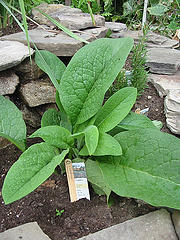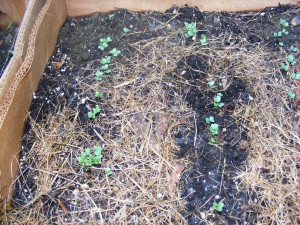
A beautiful variety of patty pan squash. Photo Credit: Mason Masteka - http://www.flickr.com/photos/masonmasteka/
A couple of more pattypan squash have pushed the lasagna bed even further ahead, at almost 2.5 pounds (1.13kg) total yield from this gardening technique. I remember over fourty years ago getting ready for “the coming of the metric system”. Now, thankfully – we’re seeing it replacing the imperial system with popular foods measured in whole metric amounts (2 litres of beverage, 1 litre of cooking oil, etc.), glad I had those lessons, wish I remembered them – but I digress.
Patty pan squash, aka pattypan, cibleme, scallopini, button squash, and others (see wikipedia for details), is similar in texture and flavor to zucchini squash. They are often picked when they are no more than three inches in diameter (76mm). At this stage, the seeds are immature enough tthat they are similar in texture to the rest of the squash and are cooked and eaten with no difficulty.
When grown beyond three inches, the seeds become tougher, the insides start to become stringy between the seeds and some of the center needs to be scooped out and composted (or the seeds saved for next year’s garden, if they are an open pollinated variety). When patty pan squash are about six inches across, the outer husk is often used as a decorative container for either the insides, mixed with flavorings or a stuffing mixture (see http://www.squidoo.com/patty-pan-squash-recipe). Other preparations for patty pan squash include grilling, steaming coating and frying, boiling, pickling and I’m sure I’ve missed a few.
Growing patty pan squash
These are some of the easiest to grow, needing good composted soil, and really enjoy a healthy dose of comfrey: I have one plant in each of two box beds with relatively bland soil. One I put last year’s dried comfrey and grass clippings in, the other I just put grass clippings. They were both about the same size, and now the comfrey enhanced plant has gotten a lot larger, despite being shaded slightly by the blackberry plants that have gotten out of hand.
Simply plant the seeds in rich soil with compost, keep watered and give them room! While they have a “bush habit”, they do grow out and will wander some. They are more of a compact vine than a bush, and can take up a 3 square foot (one meter) area with no trouble at all. As mentioned in day 71, planting cooler weather crops around the periphery, such as lettuce will allow the plants to shade them. I, unfortunately, planted the broccoli next to them, and in one of the beds the broccoli is almost completely shaded out! This may be an advantage later in the season, when the squash die back, allowing the late summer sun to reach the broccoli, creating an extended harvest.
As with all squash, powdery mildew can cut their productivity short. You can slow down and even stop powdery mildew using foliar sprays such as the use of baking soda outlined in http://www.ghorganics.com/page15.html, or milk, as outlined in clean air gardening blog.





















Recent Comments